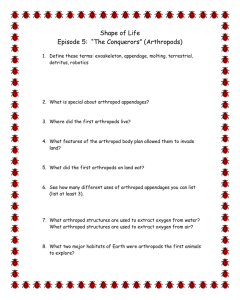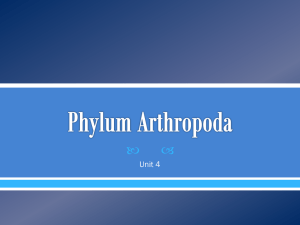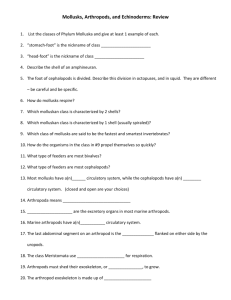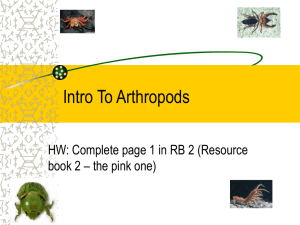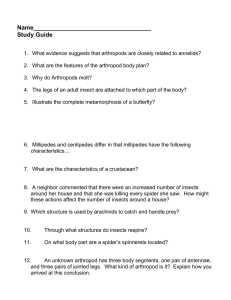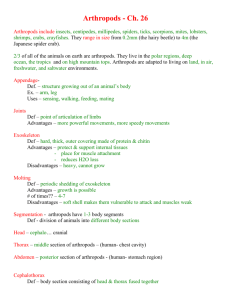Ch 28 Outline: Arthropods
advertisement
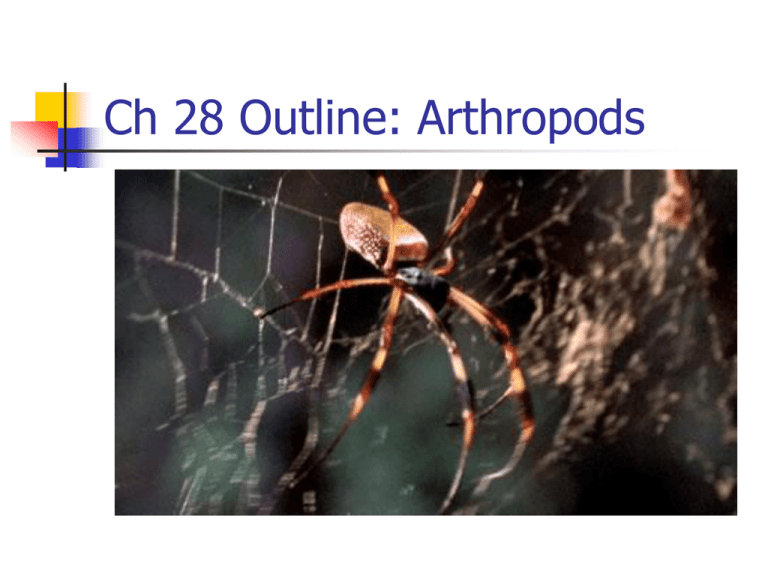
Ch 28 Outline: Arthropods What animals are in the phylum Arthropods? a. b. c. d. e. Bumble bees Spiders Octopus Lobsters Millepedes Answer: A, B, D, E Answer all that apply by holding up more than one card. There are 4 Subphyla of Arthropods List the three subphyla that are still living. If you can’t remember the names of the subphyla, write down the representative species that are in each group. Answer: chelicerates, crustaceans, uniraminans Which subphyla representatives are are matched to the proper names? A. uniramians – prawns B. chelicerates – spiders C. crustaceans – cockroaches D. triobites – millepedes 4 Subphyla: Trilobites (now extinct) Chelicerates – spiders, ticks, mites, scorpions, horseshoe crabs Crustaceans – crabs, shrimp, lobster Uniramians – centipedes, bees, moths, grasshoppers, flies, bettles Evolution: Which insects have common ancestors with modern annelids (segmented worms) A. insects B. Centipedes C. millipedes D. crustaceans E. spiders (chelicerates) (hold up multiple letters if more than one answer apply) Answer: A, B, C Evolution Insects, centipedes and millipedes seem to have common ancestors with modern annelids Crustaceans and spiders evolved from different ancestors What is special about the Velvet worm? A. it is a living fossil B. it is extinct, but has the characteristics of arthropods C. It seems to be a “transition” organism between the annelids and the arthropods D. It has larvae that are the same as insect larvae E. It makes a substance that resembles velvet Answer: C The Velvet worm Placed in its own phylum (along with others like it) Has characteristics of both annelids and arthropods The First Arthropods? What Evolutionary trends are shown within the Arthropods? A. early arthropods have a sac body plan; later arthropods have tube-within-a-tube B. early arthropods have bilateral symmetry; later arthropods have radial symmetry C. early arthropods have many smaller body segments; later arthropods have fewer but larger body segments D. early arthropods do not fly; later arthropods do E. early arthropods have many unspecialized appendages, later arthropods have fewer, more specialized appendages Answer: C and E Arthropod Evolutionary Trends Far fewer body segments (segments in embryo fuse into larger ones) Appendages become more and more specialized What are the names of the three main body segments of an insect? A. head, legs, wings B. appendages, thorax, exoskeleton C. head, thorax, abdomen D. anterior, posterior, ventral E. dorsal, ventral, posterior Answer: c Structure – head, thorax and abdomen List at least two characteristics that unify the phylum Arthropoda. (Answer on next slide) Arthropods – Characteristics that Unify Jointed appendages– antennae,claws, legs, wings,flippers, etc. Exoskeleton Segmented body Open circulatory systems What is the main molecule in exoskeletons, and what type of molecule is it? A. cellulose, a complex carbohydrate B. glucose, a simple carbohydrate C. chitin, a complex carbohydrate D. starch a complex carbohydrate E. glycogen, a complex carbohydrate Answer: C What is a major DISADVANTAGE to having an exoskeleton rather than an endoskeleton? A. it is not as strong as an endoskeleton B. it cannot heal like an endoskeleton can (if it breaks) C. it is more vulnerable to breaking since it is on the outside of the body D. it does not grow larger like an endoskeleton can E. it is not as flexible as an endoskeleton is. Answer: D Exoskeletons Made of chitin Some leathery/flexible Some waterproof Must be molted for the animal to grow There are 4 different structures that insects use to breathe. List at least 2 of them (Answer on next slide) Respiration Arthropods have 4 basic structures for respiration: Gills, Book Gills, book lungs and Tracheal tubes Respiration - Arthropods Aquatic arthropods (crabs and shrimp): GILLS Book Gills Unique to horseshoe crabs Tissues are layered Book Lungs – Layered Tissues Unique to Chelicerates Book lungs How does the air come into the insect if it is “Breathing” using tracheal tubes? A. the air moves through the tubes when the muscles move the abdominal cavity B. there is an area inside the expands and contracts like our diaphragm – this draws the air in C. they have an incurrent siphon that pulls the air through D. they use their wings to “fan” the air in Answer: A What are “spiracles”? A. the sensory receptors on the ends of antennae B. The structures that are used for hearing for insects C. the structures that are used to spin webs in spiders D. the holes that allow air into the tracheal tubes E. the barbs on the sides of some insects legs for extra traction. Answer: D Tracheal Tubes Branching tubes throughout the tissues Shrink and contract when insect’s muscles move Causes air to pump in and out of tissues Attached to spiracles (holes on outside of body) Tracheal Tubes Feeding What can insects eat? A. plants B. animals C. rotting organic matter D. fungi (mushrooms) E. bacteria Answer: ALL of the above! Modified appendages enable different arthropods to eat almost anything The Difference (s) between an open and closed circulatory system is (are): a. Closed systems have a heart (pump); open systems do not. b. Closed systems have blood vessels; open systems do not. c. Closed systems do not have sinuses (pools of blood for nutrient exchange); open systems do. d. Closed systems are more efficient at nutrient and gas exchange; open systems are less efficient. e. Humans have closed circulatory systems; arthropods have open systems Answer: C, D , E Internal Transport OPEN circulatory system with a well-developed heart (limits their size!!) Heart pumps blood through blood vessels to sinuses where gas and nutrient exchange occurs with the tissue Blood re-collects in large cavity surrounding heart and then enters heart to be pumped again Open vs. Closed Circulatory Systems Open vs Closed Circulatory Systems How do Arthropods get rid of their SOLID wastes? A. the solid waste exits back through their mouths B. The solid wastes exit through their anus C. The solid wastes exit through their spiracles D. The solid wastes exit through their Malpigian tubules E. The solid wastes exit through their sinuses Answer: B How do Arthropods get rid of their nitrogenous wastes? A. the N2 wastes are concentrated by their Malpigian tubules B. the N2 wastes are excreted through their anus C. the N2 wastes are excreted through their spiracles D. The N2 wastes are concentrated by their tracheal tubes E. The N2 wastes are excreted through their gills Answer: A, B, E Excretion Solid waste exits through anus Insects and spiders remove nitrogenous wastes with Malpighian tubules that are in the blood sinuses Nitrogenous wastes are concentrated by tubules and added to solid waste for excretion. Where (in their bodies) do Arthropods have structures to get rid of nitrogenous waste structures? A. their head B. their abdomen C. the base of their legs D. their tracheal tubes E. the ends of their antennae Answer: A, B, C Some terrestrial arthropods may also have excretory glands on base of legs. Some arthropod have these glands instead of Malpighian tubules Aquatic Arthropod Excretion Excrete metabolic wastes through gills. Lobsters also have a pair of green glands on (green gland) their head that eliminate nitrogenous wastes! How are Arthropods’ nervous systems different than humans? A. We have a brain, they only have ganglia B. Our brain controls all our body except for reflexes; their brain controls some but not all of their functions C. We have a nerve cord; they do not have a nerve cord D. our nerve cord is on our dorsal surface; theirs is on their ventral surface E. Our NS is higher functioning on all levels than their nervous systems Answer: B, & D Response –well developed NS Have brains in head that act as main coordinator, and ganglia in each segment that coordinate movement in that segment. Brain and ganglia are connected by a ventral nerve cord How do compound eyes differ from Human eyes? a. Compound eyes do not have the ability to focus an image as well as our eyes can b. Compound eyes do not see color c. Compound eyes can focus much better than our eyes because they have SO many lenses to work with. Our eyes only have one lens. d. Compound eyes see motion much better than our eyes can. e. Compound eyes produce larger images than our eyes Answer: A, D Sense organs Have simple organs – statocysts and chemoreceptors Most also have more complicated organs Compound eyes are common > 2000 separate lenses – excellent at detecting colour and movement (better that we can!) Most can detect UV light Where do Arthropods have taste buds? a. b. c. d. e. Tongue Mouth parts Legs Abdomen antennae Answer: B, C, E Crustaceans and insects have a good sense of taste “Taste-buds” located on mouthparts, legs and antenna Also have hairs that detect motion very well How are insect ears different than human ears? a. Human ears can hear much higher frequencies than insect ears b. Human ears hear much lower frequencies than insect ears c. Human ears have “ear drums” that are inside the head and much more protected than the “ear drums” of insects. d. Human ears are much better at detecting sound than insect ears e. Human ears are not as good as insect ears at detecting sound at normal ranges. Answer: C Where are the “ear drums” (tympanic membranes) on a grasshopper? a. b. c. d. e. On On On On On their their their their their Answer: c heads thorax under their wings abdomen behind their legs abdomen at the very end antennae Many insects have ears that hear frequencies higher than we can Eardrums are in different places – eg. Grasshopper have eardrums behind their legs How do insects protect themselves from predators? a. They sting or bite or pinch b. They are poisonous c. They can drop an appendage (sacrifice a limb) and run away d. They can camouflage themselves e. They mimic other animals that are poisonous Answer: All of the above! Protection Exoskeleton and good NS help Some sting, some bite, some pinch, some are poisonous Some crabs drop a claw that continues to move while they escape Some have camouflage Some mimic other animals that are poisonous Bee Stinging Camouflage mandibles Mimicry Biting Mimicry How do insects move their bodies? a. They use jet propulsion like octopi or squid. On land they use their spiracles and tracheal tubes to move air instead of water. b. They have cilia that move them through the grass or the water c. They swim in the water d. They use muscles to move their exoskeletons similar to how humans use muscle to move their endoskeletons e. They have special tissue that moves their exoskeleton from the outside. Answer: D Movement Move with muscles coordinated by NS Muscles use exoskeleton as we use endoskeleton to move What is the most common form of reproduction for arthropods? a. b. c. d. e. External fertilization Internal fertilization Spore formation Egg production Internal development Answer: B, D Reproduction Most is internal fertilization via special male organ Spiders and some crustaceans leave a package of sperm for the female to pick up How does an arthropod remove its exoskeleton when it needs to molt? a. b. c. d. The exoskeleton will crack when the arthropod’s body becomes too large The arthropods have a special internal appendage that can break open the endoskeleton from the inside. The epidermal layer digests the inner exoskeleton layer to re-cycle the chitin The arthropod must find a sharp object to scratch against to weaken the endoskeleton until it break through Answer: C Growing Requires MOLTING Coordinated by hormones 1. The epidermal layer digests the inner exoskeleton layer to re-cycle the chitin 2. Arthropod body excretes a new exoskeleton (inside the old one) 3. Animal cracks the old exoskeleton and crawls out 4. May eat the old exoskeleton 5. Animal stretches the new exoskeleton to larger size (is done by pumping extra water into the body in aquatic arthropods) New, larger exoskeleton will then harden Grasshopper eating exoskeleton Metamorphosis – A Drastic Change! Insects demonstrate 2 forms of metamorphosis – complete and incomplete Incomplete metamorphosis: a. Insects enter the pupae stage but emerge without making the complete change in Incomplete Metamorphosis grasshoppers, mites, and crustaceans the egg hatches into an immature animal that looks like the adult but lacks sex organs and other structures such as wings Complete Metamorphosis Bees, moths, beetles 4 stages: 1. Eggs 1. Eggs 2. Larvae – hatch from eggs. Look different from adult Grow bigger and molt several times. Hang upside down In “j” the day before It turns into a pupa 3. Pupa – the last molt of a larva Often has a protective coating Body completely changes and rearranges. Old parts are digested to recycling the materials just about ready to emerge 4. Adult – emerges from the pupal coccoon. Even the animals behaviour will be different than the larval stage Hormones, Molting and Metamorphosis Molting hormone interacts with other hormones such as “juvenile” hormone When juvenile hormone is high, the animal continues to molt into the larval stage. Each molt causes the animal to produce less hormone At a critical lower level of juvenile hormone, the animal will molt into the pupa When juvenile hormone is completely gone from the system, the pupa molts into the adult Some plants use chemicals that mimic insect juvenile or molting hormone as a defence mechanism Insecticides will also do this
